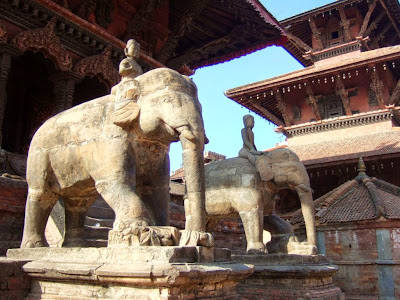
Patan City, also known as Lalitpur, is the oldest known Buddhist city of Nepal, situated on a plateau across Bagmati River 8km south of Kathmandu. Originally found in 3rd century but destroyed in 1480 and restored by Malla Kings again in 17th century, was once an independent Newar Kingdom of Nepal. Though it had undergone quite a number of political upheavals in the history, the city's glorious cultural heritage and finest craftsmanship were preserved. The monumental area within the vicinity of its Durbar Square offers the most outstanding splendor in its magnificent architectures and unique arts within the three ancient cities of Kathmandu Valley. Patan Durbar Square is one of the world heritage site listed by UNESCO.



The main attraction in Patan Durbar Square is the Royal Palace that built in 17th century at an ancient crossroad in the heart of Patan City. The Palace Complex is one of the three old Kings' Residences remained in Kathmandu Valley and the only one that has maintained its original layout and urban context through centuries. Its three courtyards were built in different period with different characters.



The three courtyards (Mul Chowk, Mani Keshar Chowk and Sundari Chowk) in Palace Complex are very rich in architectural arts heritage. There are many impressive structures and historical sites displaying the ancient architecture of Newaris and their exquisite carvings in stone, wood and metal.



Temples and shrines dedicated to various Hindu deities are aligned opposite western side of the Royal Palace. Amidst the religious buildings, there are two tall stone columns. One column is topped with a bronze image of King Yoga Narendra Malla in the posture of worshiping and the other column standing in front of Krishna Temple, is with the statue of Garud.




Jagatnarayan Temple, standing on the bank of Bagmati River in Patan Durbar Square, is a tall imposing temple dedicated to the incarnation of Lord Vishnu, Narayan. The temple established in year 1565, was the oldest building in the Square. The structure was built up with red bricks and it was full of fine stone images.



Vishwanath Temple, guided by two stone elephant statue in the front entrance is dedicated to Hindu God Shiva. It was built in 1627, with erotic carvings at its roof struts. It was said that there is a "Linga" inside the shrine.


Mul Chowk courtyard houses one of the Taleju shrines with two stone lions as entrance guardians and sitting between Mul Chowk and Mani Keshar Chowk is another temple named Degu Taleju.



The remarkable architecture of Temple Krishna Mandir and Vishnu Pagoda Temple.



The most outstanding structure is Temple Krishna Mandir. It was built in Indian Shikhara style to dedicate to Hindu God Krishna, by Malla King in year 1637. It is the only temple in Nepal that has 21 golden pinnacles. There are three floors beneath the pinnacles. Main shrine of Krishna is at 1st floor and Shiva enshrined in 2nd floor while the 3rd floor is the shrine hall for Lord Buddha. The imposing structure which is supposed to be the first specimen of Shikhara style temple in the nation, was built entirely with stone.




The 5 tiered triple roofed Taleju Bhawain Temple was first built in year 1640 but restored in 1667 after a fire. Taleju Bhawain was the personal deity to Malla Kings.


The decorative doors at external wall and images of Hindu deities.



The carvings on the wooden roof struts are gorgeous.



The intricate wood carvings in columns and walls with little images of deities.


The little Taleju Bell within the artistic designed and decorative columns is a historical relic.



Rows of beautifully carved wood columns.


Sundari Chowk (courtyard) established in year 1647 is known for its spectacularly carved stone bath and the wood ornamentation of animals and deities. It is also famous for its Tusha Hill, a beautifully carved sunken water tank.



Manga Hiti stone bath is the lotus shaped pool where water sprouting from the mouth of crocodile deities (Makaras). Channels for the source of water was built by Malla Kings from 15th century. It is a popular sport for people to look for drinking water, to wash their hands and feet or sometimes to wash their hair.


There are also some old Newari residential houses in the square..


Hiranya Varna Mahavihar Golden Temple locating in the courtyard of Kwabahal, is a Buddhist Temple in Patan Durbar Square. It was built in 12th century by King Bhaskar Verma.



The three storey golden pagoda of Shakyamuni is flanked by a pair of male and female lion sculptures at the entrance door gate.



Golden Pagoda of Buddha was covered with enormous numbers of gold and silver gilt decorations and embellished with exquisite find wood carvings.



It was said that a golden image of Buddha is enshrined on the pedestal inside the upper storey of the Pagoda with a large prayer wheel. Walls are with drawings depicting the life history of Buddha.



External corridors of Golden Pagoda are circled up by prayer wheels with statue of monkey gods placed at 4 corners.



I forgot the name of this little lovely shrine behind Golden Pagoda.



The interesting puppets and popular snack MoMo (which are actually the Chinese dumplings) at shopping alleys nearby Golden Temple.




No comments:
Post a Comment